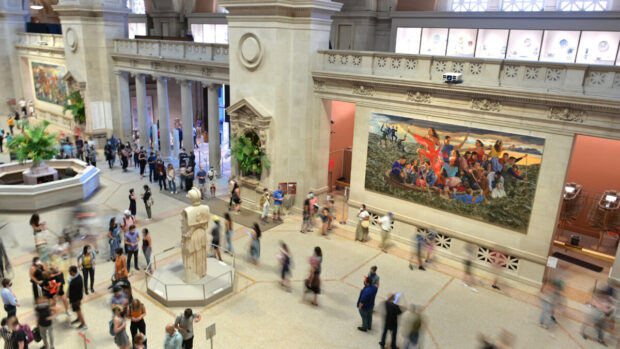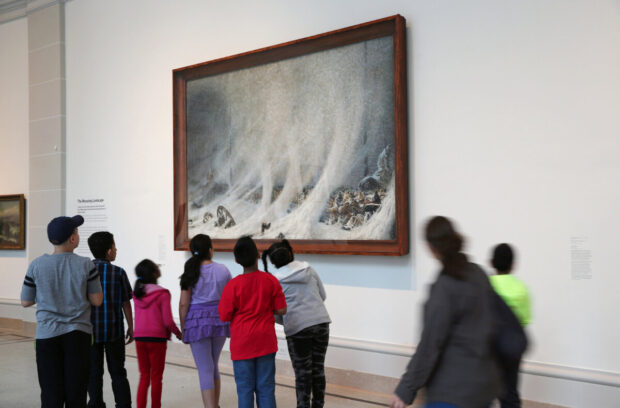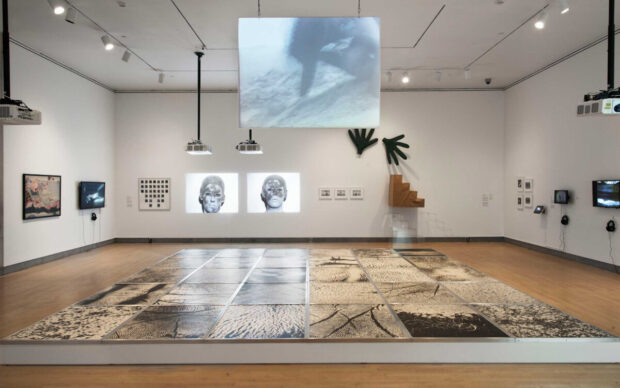
When the Brooklyn Museum reopened last weekend after completing the $ 63 million modernization work, there was a defiant mood over jazz music and cheese platters that is increasingly rare in the otherwise oversaturated New York cultural scene.
That was the mixture of curiosity, dissidence, and optimism that shaped New York from the sixties to the eighties when the city still provided the impetus in the international cultural scene and not only set the prices. The whole of Brooklyn had gathered – writers in tweed jackets from Brooklyn Heights mingled with Afro Centrically clad black educated middle classes from Fort Greene, artfully sloppy bohemians from Williamsburg, and disheveled old hippies from Park Slope.
READ Best Colleges in New York
And because the exhibition “Open House: Working In Brooklyn”, which opened at the same time, attempts to give a generally valid overview of the Brooklyn art scene, comparisons with the art world of Manhattan were inevitable. After all, the Whitney Museum of American Art biennial is currently running there, which claims to provide a general overview of young, modern art in America.
Now, however, the residents of Brooklyn are extremely passionate about local patriotism. This is where, they say, the real New Yorkers live, the real locals who have lived in the city for generations, and not just come here from the provinces for a few years to make a quick career in the Manhattan water heater and then again to move to the family-friendly suburbs.
In addition, Brooklyn would actually be the fourth largest metropolis in the USA with two and a half million inhabitants. However, the southeastern tip of Long Island also has some inferiority complexes to make up for. First, the port city of Brooklyn was demoted to the suburbs of New York City by the administrative act in 1898. From then on it went steadily downhill for almost a hundred years.
Talent and money let the lights of the big city lure them over the East River to Manhattan. Brooklyn became a dormitory city for immigrants, workers, and petty bourgeoisie, which the writer Irwin Shaw ridiculed as a “cemetery district” as early as the 1930s. Then the docks and shipyards closed, the black and immigrant neighborhoods degenerated, and Brooklyn became synonymous with gangsters, violence, and ghetto misery. Even writers like Truman Capote and Arthur Miller, or filmmakers like Martin Scorcese and Spike Lee, who glorified the unspoiled district in their works, couldn’t change that.
READ: 15 Top Biotech Companies in New York
The Brooklyn Museum also suffered from the decline of its hometown. When it opened in 1897, the neoclassical domed building with its extensive galleries, halls, and colonnades was still considered one of the most magnificent art museums in the world.
After all, the city fathers of Brooklyn had bought the architecture firm McKim, Mead & White, which carried out prestigious government contracts around the turn of the century, such as the modernization of the White House, the design of the Washington Mall and the university complexes of Harvard and Columbia, and the splendid summer homes for families on the side like the Whitneys, Vanderbilts and Pulitzers built.

But the Brooklyn Museum had no chance against the competition from the Metropolitan Museum of Art on the eastern edge of Central Park. While the Metropolitan amassed epochal art treasures from all over the world, the Brooklyn Museum had to be content with at least belonging to the premier league of museums with its Egyptian and African collections.
But while the major museums in Manhattan reported visitor numbers of up to four million a year, the number of annual visitors to Brooklyn shrank to under two hundred thousand in the 1990s. Even the cultural scandal of the decade could not change that. The then-mayor Rudolph Giuliani wanted to withdraw the city’s funds from the Brooklyn Museum because it had shown a picture of the Madonna in autumn 1999 as part of the “Sensation” exhibition, which the painter Chris Ofili had decorated with elephant dung.
The architecture firm Polshek has now put a modern glass pavilion in front of the museum with a bold swing, which takes the heavy arches of the neoclassical building away from the all too serious weight. But it is above all the forecourt that should serve as a point of attraction.
The Californian design office Wet installed a fountain there which, with its choreographed fountains, achieved the desired effect on the very first weekend. Strollers and families settled in the spring sun on the steps and stairs in front of the museum. Some strolled into the museum, others stayed a little longer after visiting the exhibition. The Brooklyn Museum thus forms a new focal point without imposing itself with urban planning gestures.

The reopening of the modernized Brooklyn Museum does not mark an artificial turning point in the history of the district, as the Board of Directors of the Museum of Modern Art is currently staging in the ailing industrial landscape of Queens, but the preliminary climax of a development that began around thirty years ago.
READ Where is Education Free in New York?
It was then that the first wave of educated citizens from Manhattan moved to Brooklyn. Neglect and crime drove the middle class out of the big cities at that time, but because life in the suburbia would have been a cultural death sentence for the cosmopolitan intellectuals of New York, they sought a compromise in Brooklyn. There you could raise families in the formerly splendid townhouses in the tree-lined streets as well as in the suburbs, without having to forego the urban environment. The first cultural enclaves emerged in Brooklyn Heights and Park Slope and soon spread in all directions.
Giuliani’s purges, the dot comboom, and the associated Americanization of Manhattan then initiated the second urban migration in the nineties. The young bohemian moved to Williamsburg and Dumbo, the educated citizens to Cobble Hill and around Prospect Park.
Because life in Brooklyn is a little more relaxed than in compressed Manhattan with its overheated real estate market, not only because of the low rents but also because of the extensive structures, there is also space here for everything that defines a lively cultural landscape – curiosity, dissidence, and Optimistic mood. If you work in Manhattan, you can’t afford to make mistakes. At a time when dissidence has become suspicious and affirmation vital, this also means no experiments. So it’s no wonder that the artist Sharon Gilbert proudly remarked on an opening evening that the “open house” exhibition was so much more political than the previously controversial Whitney Biennale. There was even an overlap.
However, “Open House” is even more diverse than the Biennale, after all, the 200 artists only have geographic similarities. There are representatives of the cultural canon such as the sculptor Louise Bourgeois and Alexis Rockman with his sensational commissioned painting from the Brooklyn riverside as a post-apocalyptic wilderness. The stylistic spectrum ranges from Pop Art such as the monumental puzzles by the Swiss Christoph Draeger and the neon sculptures by Heidi Cody to concept installations by James Cullinane and Diana Cooper, or urban ethnic artists such as Xiomara de Oliver and Lorenzo Pace to the photo art by Luis Gispert and Katy Grannan.
But Brooklyn is more than just a geographic framework. This is indicated in pieces like Jovi Schnell’s painting “Pounce In Babel”, or in Nina Levy’s rubber replicas of her neighbors.
Brooklyn is an identity generator that can give the rootless and restless cosmopolitan of the megalopolis New York an urban home. “Lateral growth – the social transformation of New York beyond Manhattan – is likely to be the city’s most interesting development in the foreseeable future,” wrote the architecture critic for the New York Times. Herbert Muschamp, in his review of the modernized Brooklyn Museum. That would save the dream of New York because the city would be borderless again.
Like us on Facebook for more stories like this: